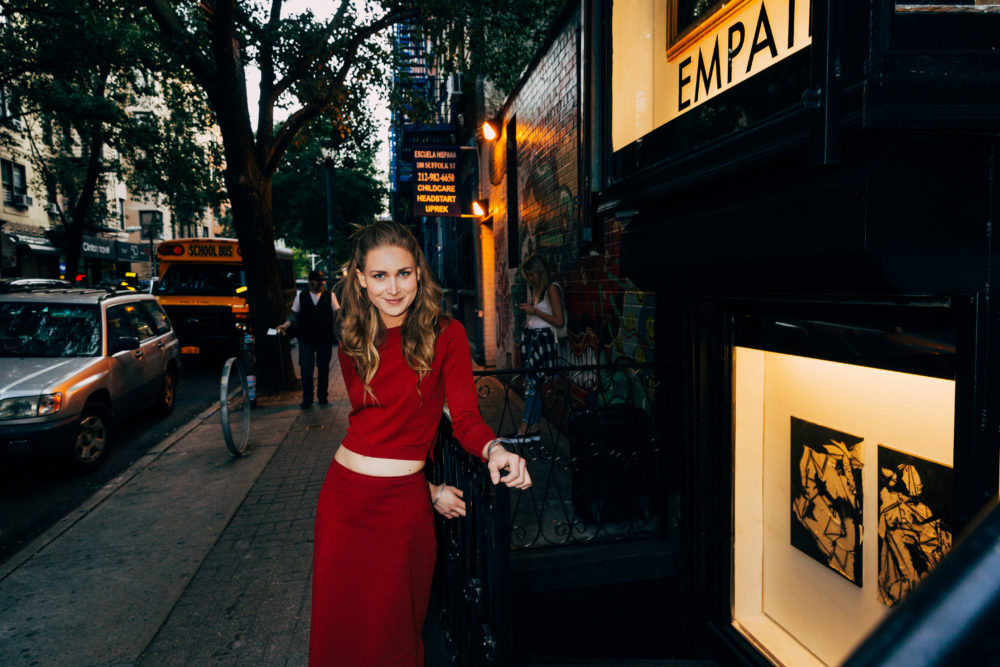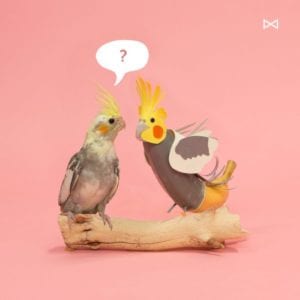The visual arts frequently serve as a reflection of the current zeitgeist, succinctly stating complex socio-political ideas in a single image. There are some artists, however, whose works do not merely reflect, but propagate and pose questions of immense cultural impact. We’ve come to understand the power that even satiric works of art can have, for example, through the horrific events that unfolded at Charlie Hebdo in 2015. Thankfully, modern artists have refused to back down in their willingness to capture and poke fun at world leaders and the madness they so often cause.
Mark Bryan is one such artist who uses parody not just to get a few laughs, but also to explore the darker sides of subjects like religion and politics. Bryan’s wry humor and wit don’t conceal his lapidary technique, either. His works depicting Trump will literally make you laugh out loud while appreciating the intricate detail he took care to display.
We talked with Bryan about his background, his process, and the elements of his works that make them so hilariously beautiful.
Art Zealous: You write of your early life, “The constant threat of atomic annihilation, the civil rights movement, Vietnam War, and the Kennedy and King assassinations further provoked a political awareness and a sense that all is not right with the human species.” Is the socio-political climate similar now to that of your early life? Does your current political work hark back to those times for you?
Mark Bryan: Certainly the threat of nuclear war (and just plain old war) is still with us. The struggle between the interests of the common man versus the rich and powerful continues unabated. The human story seems to go on like always but with new scenery and better gadgets. As Will Rogers said “You can’t say civilization don’t advance…in every war they kill you in a new way.” I don’t want to be entirely cynical, because some things have improved such as civil rights, LBGT acceptance, and environmental awareness, but they have a long way to go. I still hold out some hope for us.
When I was young, optimism and naiveté gave me hope that our generation was going to change everything wrong with the world. I’ve learned that instead, it is a never-ending fight that must be maintained to keep bad things from happening. I suppose by our human nature we will always be vulnerable to the manipulation of our fears and prejudices. Trump’s victory only confirms this. People like him and the tactics that he uses are nothing new. What is most disappointing and frightening to me is that so many Americans today seem to welcome and agree with his message. I remember Nixon and Watergate well. It looks like we are headed down that road right now. I only hope the outcome is similar for Trump. I feel like I must do my small part by pushing back with my art.
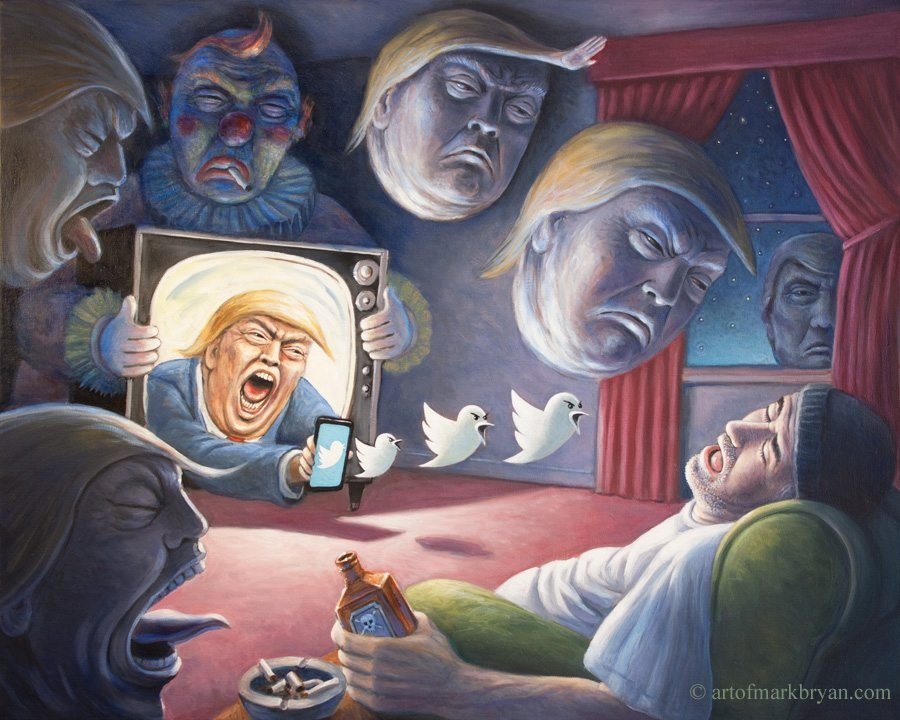
AZ: Do you remember any specific “cheesy sci-fi and horror movies” from your youth that affected you in a significant way?
MB: I did see a bunch of cheesy sci-fi films back in the day and loved them dearly, but I have to say the ones that had the biggest influence were not cheesy at all. “Forbidden Planet” and “The Day the Earth Stood Still” were both terrific and contained strong messages that were prevalent in the 50’s: the hidden and dangerous human subconscious and the potentially destructive power of atomic technology. And it goes without saying that the flying saucers and robots were awesome too.
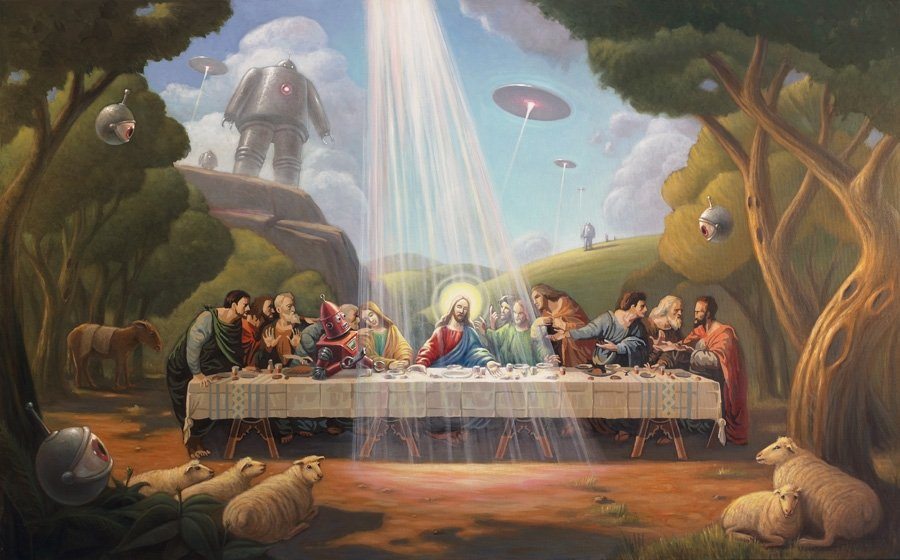
AZ: You mention that you don’t spend a lot of time planning your paintings, with the exception of your political works. What goes into the planning process for those works, and why do they require a plan where your other pieces don’t?
MB: Because a political work is about specific topics and people, it needs to reflect that reality and have a clear point of view. That requirement does not lend itself to the freewheeling approach I take to my other works, which are open to wherever they can take me.
Unlike political cartoonists, who create works daily about timely events, I make very few. I am inclined to create more general statements about what is happening. I think about the subject for quite awhile until a picture begins to come forward that would best express my thoughts and feelings. I then begin to make pencil sketches to help with the visualization. When it is somewhat realized I begin with the painting. Even though it is planned to a large degree, I do make changes and additions as I go when new ideas pop up.
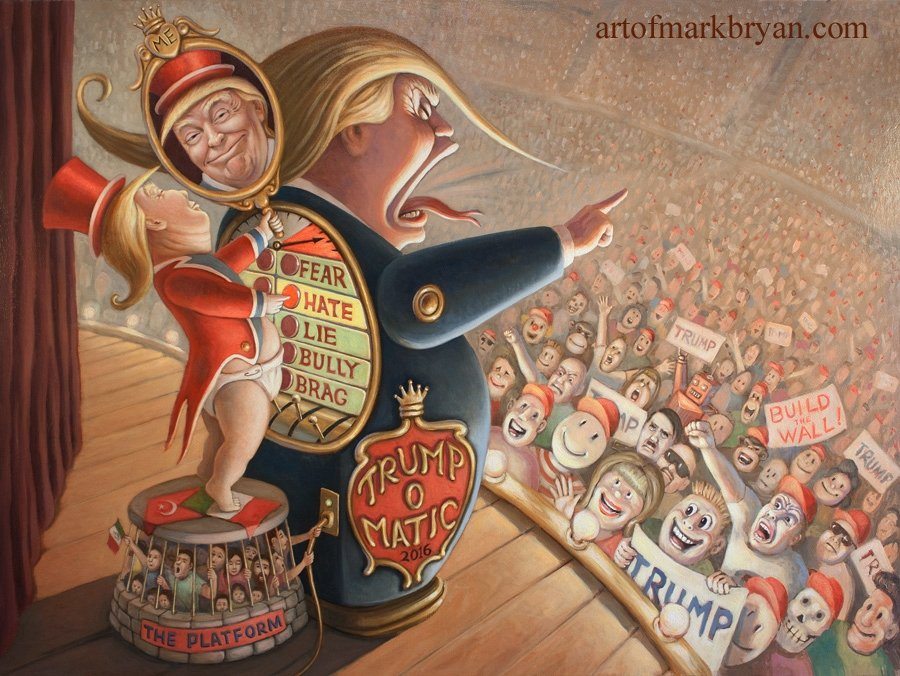
AZ: In your artist statement you write, “Hopefully these pictures say something about all of us.” Could you tell us what you believe your pictures say about you?
MB: I’ve often said that painting is like psychoanalysis, only cheaper. Of course, they say you get what you pay for. Painting certainly makes me feel better. I’m not sure why. Probably because self-expression has a therapeutic effect. As Laurie Lipton says, “Better out than in.”
My objective view says that there is a high level of anxiety and pessimism in most of my work, but it is always tempered with humor and absurdity. You gotta laugh, right? In my defense, a somewhat dark take on the world seems only rational given the circumstances. In spite of the negative and disturbing qualities of much of my work, I believe some joy of life and fun bleeds through to the surface. I’d like to think that I can tell stories that have meaning to others, that have truth in them and still give them a way to laugh about it. My approach to art is also a way for me to deal with the uncertainties and injustice in the world while at the same time see the wonder of it all.
AZ: Many of your recurring characters/creatures are featured in both your political and your non-political works. Do they hold the same significance in the different genres?
MB: Yes, clowns, monkeys, pigs, and sheep play well in both pop surrealism and political satire. There is some overlap in these two genres for sure and their symbolism is obvious. Even in my “just for fun” works, social or political elements seem to creep in. “Return of the Clown Heads,” for example, started out as whimsy but can also be seen as commentary, especially now.
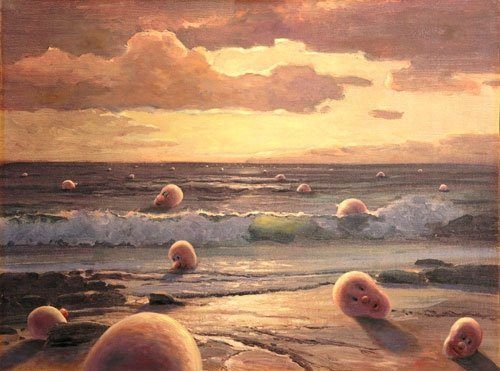
AZ: How and why do you maintain such a consistent palette and style? When you think of a subject to paint, do you automatically imagine it within your own caricature-esque, muted-color style?
MB: My painting style has evolved over time. Earlier works were much brighter and more saturated than the current ones. They were always on “11.” Over time I’ve learned to use a more subtle palette with a broader use of light and dark. This allows intense colors to really pop and also to direct the eye where desired. I do imagine a palette at the start of a work, but it is mostly worked out in the process.
To have my style somewhat settled is good because it allows me to focus primarily on telling the story. I find the idea behind the work to be more challenging and interesting than the technical side of painting. In order for the story to be told effectively, the style must naturally be representational and illustrative. Because each work is a new story, I am never bored with the execution part.
AZ: Have you ever experimented with mediums outside of oil on canvas? If so, how did that experience differ from your normal work with oil?
MB: Up until about 2000, I painted exclusively with acrylic paint, mostly on panels. As my style changed and became more traditional and modeled, I became frustrated with acrylic paints and switched to oil. The working time for acrylics is short, blending color is difficult, and it is almost impossible to match colors once they have dried. To me, oil paints are just richer and better looking. They also work much better for wet on wet painting and glazing, techniques which I employ in most of my paintings.
AZ: What is the significance of Hello Kitty in your works?
MB: I like to work with pop culture icons because they are familiar to almost everyone. Hello Kitty has no specific meaning to me other than cuteness, Japanese weirdness, and her appeal to little girls. To take a popular and innocuous figure such as her and imply subversive motives and agendas is an enjoyable exercise for me.
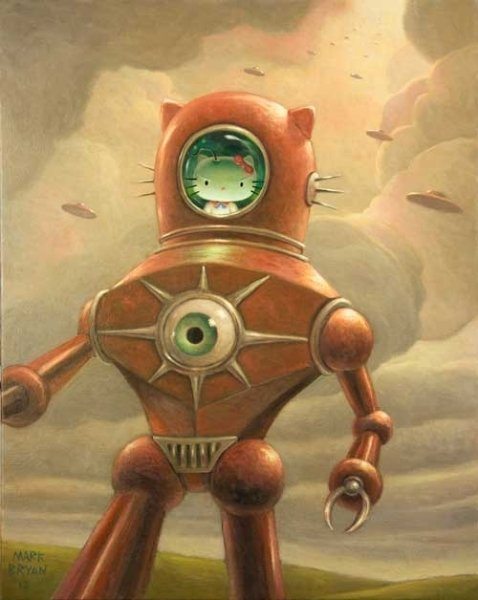
AZ: You’ve said that painting is like “dreaming while awake.” Are any of your works depictions of actual dreams you’ve had while asleep? Your affinity for Dalí comes to mind, whose notable method of sleeping and waking himself up with the drop of a key inspired many of his paintings.
MB: It’s funny to me how dreams make perfect sense until you wake up and think about them carefully. It is a fascinating phenomenon that we have this ability to create entire worlds within our minds that are so convincingly real. This begs the question, how real is this so-called waking life that we inhabit? I have made paintings of my dreams, those that were especially mysterious, intriguing, or surprising.
What I mean by “dreaming while awake” is a state in which I allow the mind to be open to visions, ideas, pictures, etc. that were not imagined at the outset of the painting. I also must be willing to change the painting accordingly when they arise. I believe this is the “creative leap” where the mind suddenly makes new and surprising juxtapositions between things that were before seemingly unrelated. This ability to see pictures and connections that do not yet exist is probably very much like the mechanism of dreaming. I find this approach to painting the most enjoyable, since each new work is an adventure that unfolds and takes you to an unexpected place.

AZ: There seems to be some classical influence in several of your pieces. Could you tell us about this aspect of your work?
MB: My mother used to take me to museums when I was little. Most of what we saw were old European paintings with Christian topics and others which harkened back to Roman mythology. I was always attracted to this classic work because of the realism and the stories they told. I like to play with religious and mythological themes, as these are belief systems humans have used forever to try to explain our existence and purpose in this world. It is interesting that these invented beliefs can also be used by their purveyors to control society, enforce conformity, and benefit themselves. Our imagination has no bounds in this realm. What will we make up next?
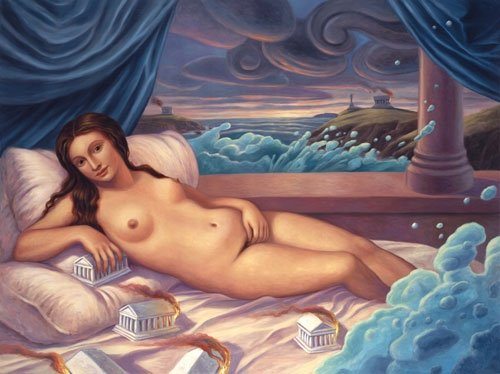
AZ: Almost all of your subjects smile in such an unnerving way. What is it about smiling that you aim to capture in your work?
MB: While showing my “Space Monkey” portrait to my grandson he said, “Grandpa, I don’t like ‘Space Monkey.'” “Why not? He’s happy,” I asked. He replied, “Yes, but he’s too happy.” I think that says it all. I enjoy making portraits that engage the viewer with eye contact and a hint of something not being quite right with them manifested by a wry smile or one that is too big for comfort.
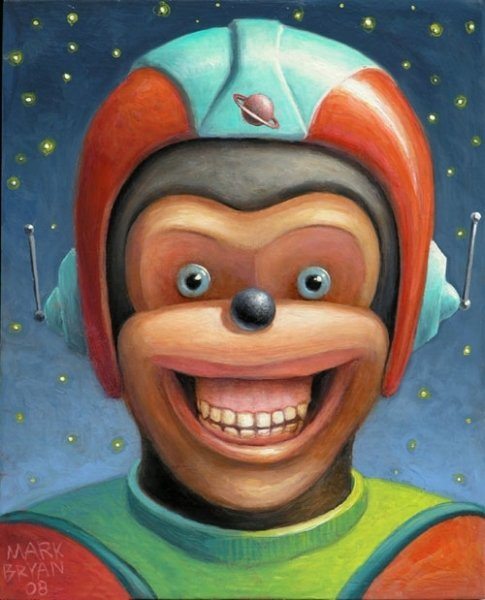
AZ: There is an exclamation point ending the “All Rights Reserved!” at the bottom of your web page. Just humor, or have you had some plagiarism problems?
MB: I didn’t notice that. My web guy put that there. It may as well be for humor, because anything you put on the internet seems to be fair game for copying. That’s both good and bad. I don’t mind having my work shared with attribution on social media, blogs, interviews, or articles. More exposure is always appreciated. I do try to keep high-resolution images off the internet so that quality reproductions are difficult. People have made small items and tee shirts and things like that but as far as I know, no large scale commercial use has happened without my permission.
At times my work is used without attribution, cropped, or my copyright removed. One time a Trump piece was altered in Photoshop by replacing Trump’s face with Hillary’s. That went viral and really pissed me off. Not only because it changed the message, but also because it was so poorly done and they left my name on it. It’s impossible to control stuff like that.
AZ: Do you have any upcoming projects or exhibitions?
MB: I will be in a show in San Francisco on April 14th at the Modern Eden Gallery, called “Animation Reimagined.” Several artists will present new takes on iconic cartoon characters. I also have a new book of my work just out called “Pictures in My Head:” The Art of Mark Bryan. It contains over a hundred color reproductions, and it will be available soon on my website. Finally, even though I said no more Trump paintings, I have a new Trump piece in the works.
AZ: How can we keep up with your work?
MB: Web site, Instagram, Facebook, and email: chimp@artofmarkbryan.com.
Top Image: “The Nightmare” Photo // courtesy of Mark Bryan

